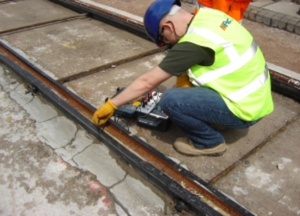Stray Current Corrosion Protection System: Testing

Earthing Services is regularly required to undertake construction phase quality audit testing as well as final system testing and commissioning on DC rail systems to ensure that a given site meets the target performance in terms of its rail to earth results, and its rail continuity results. The company is often contacted to undertake fault finding varieties of stray current testing too, which is a more involved and laborious process, but nonetheless necessary when it comes to identifying deficiencies within the system.
Electrical current will always follow a path of least resistance and so notionally when a length of rail is considered the rail itself will always present a better conductor than the concrete or soil that sits beyond the insulation in embedded rail. Even conductive materials have performance tolerances in terms of their current carrying capacity and the way in which electricity is being introduced will also contribute to performance. The way that rail performs as a conductor is impacted on by the way in which the circuit is arranged. Generally in light rail systems positive charge powers the tram, carriage, or street car, but when it is breaking the running rails serve as a negative return circuit for the current to return to the substation. This “dumping” of electrical current is not dissimilar from a lightning strike in terms of a short duration surge. If one considers how a length gutter works with water it may be easier to understand. If water is steadily, but constantly, poured into a gutter it is likely that the trickle or flow will be easily handled by the pipe; however, if a bucket of water is thrown in all at once then inevitably an amount of it will spill over. As such in light rail systems it is inevitable in embedded rail that an amount of current may leave the rail, however keeping that within the tolerances of the construction specification is vital.
Stray Current Corrosion Protection System Testing: Rail to Earth Test
The rail to earth tests that Earthing Services engineers undertake establish whether there is sufficient electrical resistance between the running rail and the surrounding ground mass, which would ensure the path of least electrical resistance remains the rail itself. This variety of test is recommended to be used throughout stages of construction and is likely to be a requirement for final approval with the client.
Stray Current Corrosion Protection System Testing: Rail Continuity Test
Rail continuity testing determines the electrical conductance performance of a system. If a rail has been appropriately welded between lengths it is highly likely that it will pass a rail continuity test. In the event that welds have not been effectively completed it is possible that they may introduce electrical resistance, which would in turn generate heat on the rails, and by a potential source of stray current. This variety of test is recommended to be undertaken whenever final welds have been completed on lengths of track.
Stray Current Corrosion Protection System Testing: Interfacing Element Test
Earthing Services provide on site testing teams, along with training sessions on construction phase testing of interfacing elements to identify any stray current paths before they are lost beneath the concrete pours. Whether it be establishing the isolation of the rail from base plates or clarifying the performance of bonds to adjacent structures, this variety of testing activity is a recommended process for all light rail systems.
